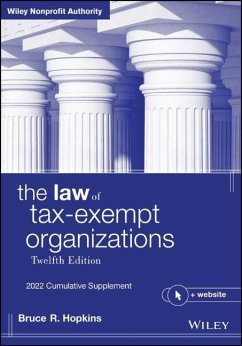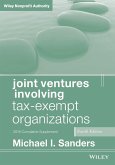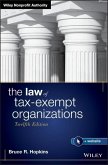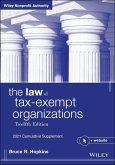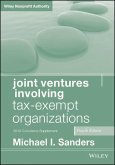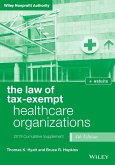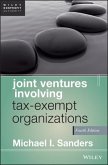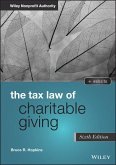Bruce R. Hopkins
The Law of Tax-Exempt Organizations: 2022 Cumulative Supplement
Bruce R. Hopkins
The Law of Tax-Exempt Organizations: 2022 Cumulative Supplement
- Broschiertes Buch
- Merkliste
- Auf die Merkliste
- Bewerten Bewerten
- Teilen
- Produkt teilen
- Produkterinnerung
- Produkterinnerung
Stay informed of every major development in the law of tax-exempt organizations from 2021 and 2022 In the 2022 Cumulative Supplement to the twelfth edition of The Law of Tax-Exempt Organizations, readers will find an essential update covering and explaining every relevant and impactful legislative and regulatory change, as well as major cases and decisions from 2021, that will affect the administration and operation of tax-exempt organizations in the United States. Renowned author Bruce R. Hopkins offers concise and authoritative commentary on the latest amendments and legislation of interest…mehr
Andere Kunden interessierten sich auch für
![Joint Ventures Involving Tax-Exempt Organizations, 2018 Cumulative Supplement Joint Ventures Involving Tax-Exempt Organizations, 2018 Cumulative Supplement]() Michael I. SandersJoint Ventures Involving Tax-Exempt Organizations, 2018 Cumulative Supplement156,99 €
Michael I. SandersJoint Ventures Involving Tax-Exempt Organizations, 2018 Cumulative Supplement156,99 €![The Law of Tax-Exempt Organizations The Law of Tax-Exempt Organizations]() Bruce R. HopkinsThe Law of Tax-Exempt Organizations343,99 €
Bruce R. HopkinsThe Law of Tax-Exempt Organizations343,99 €![The Law of Tax-Exempt Organizations, + Website The Law of Tax-Exempt Organizations, + Website]() Bruce R. HopkinsThe Law of Tax-Exempt Organizations, + Website257,99 €
Bruce R. HopkinsThe Law of Tax-Exempt Organizations, + Website257,99 €![Joint Ventures Involving Tax-Exempt Organizations, 2019 Cumulative Supplement Joint Ventures Involving Tax-Exempt Organizations, 2019 Cumulative Supplement]() Michael I. SandersJoint Ventures Involving Tax-Exempt Organizations, 2019 Cumulative Supplement157,99 €
Michael I. SandersJoint Ventures Involving Tax-Exempt Organizations, 2019 Cumulative Supplement157,99 €![The Law of Tax-Exempt Healthcare Organizations, + Website The Law of Tax-Exempt Healthcare Organizations, + Website]() Thomas K. HyattThe Law of Tax-Exempt Healthcare Organizations, + Website234,99 €
Thomas K. HyattThe Law of Tax-Exempt Healthcare Organizations, + Website234,99 €![Joint Ventures Involving Tax-Exempt Organizations Joint Ventures Involving Tax-Exempt Organizations]() Michael I. SandersJoint Ventures Involving Tax-Exempt Organizations321,99 €
Michael I. SandersJoint Ventures Involving Tax-Exempt Organizations321,99 €![The Tax Law of Charitable Giving The Tax Law of Charitable Giving]() Bruce R. HopkinsThe Tax Law of Charitable Giving313,99 €
Bruce R. HopkinsThe Tax Law of Charitable Giving313,99 €-
-
-
Stay informed of every major development in the law of tax-exempt organizations from 2021 and 2022 In the 2022 Cumulative Supplement to the twelfth edition of The Law of Tax-Exempt Organizations, readers will find an essential update covering and explaining every relevant and impactful legislative and regulatory change, as well as major cases and decisions from 2021, that will affect the administration and operation of tax-exempt organizations in the United States. Renowned author Bruce R. Hopkins offers concise and authoritative commentary on the latest amendments and legislation of interest to the leaders and managers of tax-exempt organizations and the lawyers, accountants, and consultants who serve and advise them.
Hinweis: Dieser Artikel kann nur an eine deutsche Lieferadresse ausgeliefert werden.
Hinweis: Dieser Artikel kann nur an eine deutsche Lieferadresse ausgeliefert werden.
Produktdetails
- Produktdetails
- Verlag: Wiley / Wiley & Sons
- Artikelnr. des Verlages: 1W119873380
- 12. Aufl.
- Seitenzahl: 256
- Erscheinungstermin: 29. März 2022
- Englisch
- Abmessung: 250mm x 176mm x 18mm
- Gewicht: 436g
- ISBN-13: 9781119873389
- ISBN-10: 111987338X
- Artikelnr.: 62762809
- Herstellerkennzeichnung
- Libri GmbH
- Europaallee 1
- 36244 Bad Hersfeld
- gpsr@libri.de
- Verlag: Wiley / Wiley & Sons
- Artikelnr. des Verlages: 1W119873380
- 12. Aufl.
- Seitenzahl: 256
- Erscheinungstermin: 29. März 2022
- Englisch
- Abmessung: 250mm x 176mm x 18mm
- Gewicht: 436g
- ISBN-13: 9781119873389
- ISBN-10: 111987338X
- Artikelnr.: 62762809
- Herstellerkennzeichnung
- Libri GmbH
- Europaallee 1
- 36244 Bad Hersfeld
- gpsr@libri.de
A Letter to the Reader xvAbout the Author xviiPreface xixAbout the Online Resources xxiBook Citations xxiiiPart One: Introduction to the Law Of Tax-exempt Organizations1 Definition of and Rationales for Tax-Exempt Organizations 3 1.1 Definition of Nonprofit Organization 3(a) Nonprofit Organization Defined 3 1.2 Definition of Tax-Exempt Organization 42 Overview of Nonprofit Sector and Tax-Exempt Organizations 5 2.1 Profile of Nonprofit Sector 5 2.2 Organization of IRS 7(a) IRS in General 7(a-1) Prospective Restructuring of IRS 7(b) Tax Exempt and Government Entities Division 8Part Two: Fundamentals of the Law Of Tax-exempt Organizations 3 Tax Exemption: Source and Recognition 11 3.2 Recognition of Tax Exemption 11(a) General Rules 11 3.3 Recognition of Public Charity, Private Foundation Status 114 Organizational, Operational, and Related Tests and Doctrines 13 4.1 Forms of Tax-Exempt Organizations 13(a) General Rules 13 4.3 Organizational Test 13(b) Dissolution Requirements 14 4.5 Operational Test 14(a) Basic Rules 14 4.7 Commensurate Test 14 4.8 State Action Doctrine 14(d) Statutory Law 14 4.9 Commerciality Doctrine 14(e) Other Applications of Doctrine 14(f) Elements of Commerciality 15(g) IRS Ruling Policy 15(h) Contemporary Perspective on Doctrine 165 Nonprofit Governance 17 5.3 Board Duties and Responsibilities 17(a) Duty of Care 17(b) Duty of Loyalty 18(c) Duty of Obedience 18 5.7 IRS and Governance 19(c) IRS Ruling Policy 19Part Three: Tax-exempt Charitable Organizations 6 Concept of Charitable 23 6.2 Public Policy Doctrine 23(b) Race-Based Discrimination 23 6.3 Collateral Concepts 23(a) Requirement of Charitable Class 23(i) Illegal Activities 247 Charitable Organizations 27 7.2 Relief of Distressed 27(b) Disaster Relief Programs 27 7.4 Provision of Housing 32 7.6 Promotion of Health 32(a) Hospital Law in General 32(b) Additional Statutory Requirements for Hospitals 33 7.7 Lessening Burdens of Government 34 7.8 Advancement of Education 34 7.11 Promotion of Social Welfare 35 7.14 Fundraising Organizations 35(c) Other Exemption Issues 35 7.15 Instrumentalities of Government 36 7.16 Other Categories of Charity 36(a) Environmental Protection 36(e) Local Economic Development 36 7.17 Qualified Opportunity Zones 368 Educational Organizations 39 8.1 Federal Tax Law Definition of Educational 39 8.3 Educational Institutions 39(a) Schools, Colleges, and Universities 39 8.4 Instruction of Individuals 40 8.5 Instruction of Public 409 Scientific Organizations 41 9.2 Concept of Research 4110 Religious Organizations 43 10.1 Constitutional Law Framework 43(a) General Constitutional Law Principles 43(c) Internal Revenue Code Provisions 44 10.2 Federal Tax Law Definition of Religion 44(c) Abuse of Tax Exemption 44 10.3 Churches and Similar Institutions 44(c) Principle of Respect for Autonomy 44 10.5 Integrated Auxiliaries of Churches 44 10.7 Religious Orders 4511 Other Types of Charitable Organizations 47 11.2 Amateur Sports Organizations 47 11.8 Donor-Advised Funds 47(b) Statutory Criteria 47(c) Portrait of Donor-Advised Fund Universe 47(d) Litigation 49 11.9 Endowment Funds 50(b) College and University Endowment Tax 5012 Public Charities and Private Foundations 55 12.1 Federal Tax Law Definition of Private Foundation 55(a) Private Foundation Defined 55 12.3 Categories of Public Charities 55(b) Publicly Supported Charities 55(c) Supporting Organizations 56 12.4 Private Foundation Rules 56(f) Other Provisions 56Part Four: other Tax-exempt Organizations 13 Social Welfare Organizations 59 13.1 Concept of Social Welfare 59(b) Benefits to Members 59 13.3 Conduct of Business 5914 Business Leagues and Similar Organizations 61 14.1 Concept of Business League 61(a) General Principles 61(g) Certification Programs 61 14.2 Disqualifying Activities 62(a) Line-of-Business Requirement 62(c) Performance of Particular Services 62(d) Private Inurement 63(d-1) Private Benefit 6315 Social Clubs 65 15.1 Social Clubs in General 65(b) Club Functions 65 15.4 Exceptions to Limitations 65 15.5 Taxation of Social Clubs 6516 Labor, Agricultural, and Horticultural Organizations 67 16.1 Labor Organizations 67 16.2 Agricultural Organizations 6717 Political Organizations 69 17.4 Public Policy Advocacy Activities 69 17.5 Taxation of Political Organizations 6918 Employee Benefit Funds 71 18.3 Voluntary Employees' Beneficiary Associations 7119 Other Categories of Tax-Exempt Organizations 73 19.4 Fraternal Organizations 73(a) Fraternal Beneficiary Societies 73 19.6 Cemetery Companies 73 19.11 Veterans' Organizations 73(a) General Rules 73 19.12 Farmers' Cooperatives 74 19.14 Homeowners' Associations 74 19.18 Qualified Health Insurance Issuers 74 19.20 ABLE Programs 74 19.22 Governmental and Quasi-Governmental Entities 75(a) Intergovernmental Immunity 75(b) Income Exclusion Rule 75(c) Integral Parts of States 75 19.24 Other Categories of Tax-Exempt Organizations 75Part Five: Principal Exempt Organization Laws20 Private Inurement and Private Benefit Doctrines 79 20.4 Compensation Issues 79(b) Determining Reasonableness of Compensation 79 20.5 Executive Compensation Tax 80(a) Statutory Law 80(b) Perspectives 80(c) Regulations 81(d) TIGTA Examination 85 20.6 Other Forms of Private Inurement 85(a) Rental Arrangements 85(b) Lending Arrangements 86(c) Sales of Assets 86(e) Equity Distributions 86(h) Tax Avoidance Schemes 86(i) Services Rendered 86(j) Business Referral Operations 87(l) Retained Interests 87(m-1) Successors to For-Profit Companies 87 20.12 Private Inurement and Other Categories of Exempt Organizations 88 20.13 Private Benefit Doctrine 89(a) General Rules 89(c) Joint Venture Law 90(d) Perspective 9021 Intermediate Sanctions 91 21.3 Disqualified Persons 91 21.4 Transactions Involved 91(c) Automatic Excess Benefit Transactions in General 91 21.16 Interrelationship with Private Inurement Doctrine 9222 Legislative Activities by Tax-Exempt Organizations 93 22.3 Lobbying by Charitable Organizations 93(b) Concept of Lobbying 93(c) Substantial Part Test 93(d) Expenditure Test 93 22.3 Legislative Activities of Business Leagues 94(a) Business Expense Deduction Disallowance Rules 9423 Political Campaign Activities by Tax-Exempt Organizations 95 23.2 Prohibition on Charitable Organizations 95(b) Participation or Intervention 95 23.3 Political Campaign Expenditures and Tax Sanctions 95 23.6 Political Activities of Social Welfare Organizations 96(a) Allowable Campaign Activity 9624 Unrelated Business: Basic Rules 97 24.1 Introduction to Unrelated Business Rules 97 24.2 Definition of Trade or Business 97(j) Concept of Investment Plus 97 24.3 Definition of Regularly Carried On 97(a) General Principles 97(b) Determining Regularity 98 24.4A Deemed Unrelated Business Income 98 24.5 Contemporary Applications of Unrelated Business Rules 98(i) Fundraising 98(q) Other Organizations' Exempt Functions 98 24.9 Unrelated Debt-Financed Income 98(c) Acquisition Indebtedness 98(d) Exempt Function Borrowing 99(e) Administrative Needs Borrowing 10025 Unrelated Business: Modifications, Exceptions, Special Rules, and Taxation 101 25.1 Modifications 101(g) Royalties 101(h) Rent 102(l-1) Income from Subsidiaries 102(n-1) Global Intangible Low-Taxed Income 103 25.2 Exceptions 103(a) Volunteer-Conducted Businesses 103(b) Convenience Businesses 104(c) Sales of Gift Items 104(h) Gambling 105(i) Low-Cost Articles 105(l) Associate Member Dues 105 25.3 Special Rules 105 25.4 Fringe Benefit Rules 106 25.5 "Bucketing" Rule 106(a) Statutory Law 106(b) Final Regulations 106(c) Medical Marijuana Dispensary Cases 110 25.7 Deduction Rules 111(a) General Rules 111(b) Charitable Deduction 112(c) Specific Deduction 112(d) Net Operating Losses 112Part Six: Acquisition and Maintenance of Tax Exemption26 Exemption Recognition and Notice Processes 117 26.1 Recognition Application Procedure 117(a) Introduction 117(b) General Procedures 118(c) Completed Application 120(d) User Fees 120(e) Penalties for Perjury 120(g) Streamlined Application 120(h) Reliance on Determination Letters 121(i) Post-Determination Review 121 26.3 Nonprivate Foundation Status 121(a) Notice Requirement 121 26.4 Requirements for Social Welfare Organizations 122 26.10 Rules for Other Categories of Organizations 122 26.10a Determination Letter Requests on Form 8940 122(a) General Rules 122(b) Changes in Public Charity/Private Foundation Status 123 26.10b Withdrawal of Request for Determination Letter 124 26.11 Group Exemption Rules 124(a) General Rules 124(b) Advantages and Disadvantages of Group Exemption 124(c) Proposed Revised Procedures 124 26.12 Suspension of Tax Exemption 129 26.13 Notice Requirements for Social Welfare Organizations 129 26.14 Notice Requirements for Political Organizations 130 26.16 Forfeiture of Tax Exemption 130 26.17 Constitutional Law Aspects of Process 13027 Administrative and Litigation Procedures 133 27.1 Administrative Procedures Where Recognition Denied 133(a) Requests Receiving Appeals Office Consideration 133(b) Matters Not Receiving Appeals Office Consideration 134 27.3 Retroactive Revocation of Tax-Exempt Status 134 27.5 Revocation of Tax-Exempt Status: Litigation Procedures 135(a) General Rules 135(b) Declaratory Judgment Rules 137 27.6 IRS Examination Procedures and Practices 138(a) General IRS Exempt Organizations Audit Procedures and Practices 138(b) IRS Exempt Organizations Examination Guidelines 139(c) Church Audits 143 27.9 IRS Disclosure to State Officials 14328 Operational Requirements 145 28.1 Changes in Operations or Form 145(a) Changes in Operations 145 28.2 Annual Reporting Rules 146(a) Overview of Annual Information Returns 146(b) Content of Annual Information Returns 147(c) Exceptions to Reporting Requirements 150(e) Group Returns 151 28.3 Notification Requirement 151 28.5 Filing Requirements and Tax-Exempt Status 151 28.5a Pre-Revocation Notice by IRS 152 28.8 Electronic Filing Rules 152(d) Law Revision in 2020 152 28.9 Unrelated Business Income Tax Returns 152 28.10 IRS Document Disclosure Rules 153(a) Federal Tax Law Disclosure Requirements 153 28.11 Document Disclosure Obligations of Exempt Organizations 153(a) General Rules 153(d) Failure to Comply 154(g) Penalties 154(i) Donor Information Disclosure 154(j) Donor Information Disclosure--State Fundraising Laws 155 28.14 Insurance Activities 159(b) Commercial-Type Insurance Rules 159(c) Charitable Split-Dollar Insurance Plans 159 28.17 Tax-Exempt Organizations and Tax Shelters 160 28.17 International Grantmaking Requirements 160(a) Charitable Organizations Generally 160(b) Private Foundations 160(c) Anti-Terrorist Financing Guidelines 161 28.18 Recordkeeping Requirements 16128a Tax-Exempt Organizations and Tax Shelters 163 28a.1 Concept of Tax Shelter 164 28a.2 Judicial Doctrines 165(a) Sham Transaction Doctrine 165(b) Economic Substance Doctrine 166(c) Business Purpose Doctrine 166(d) Substance-over-Form Doctrine 166(e) Step Transaction Doctrine 167(f) Countervailing Case Law 168 28a.3 Tax Shelter Law in General 169(a) IRS's Office of Tax Shelter Analysis 169(b) Other IRS Initiatives 169(c) Reportable Transactions 170(d) Participation in Reportable Transactions 171(e) Participant Disclosure Requirements 171(f) Material Advisor Disclosures 172(g) Material Advisors Lists Requirements 173(h) Abusive Tax Shelter Promotion Penalty 173(i) Other Tax Shelter Penalties 174 28a.4 Exempt Organizations and Tax Shelter Penalties 175 28a.5 Exempt Organizations' Involvement in Shelters 176(a) Transfers of Incidence of Taxation 176(b) Abuse of Corporations Sole 178(c) A Disputed Tax Shelter 179(d) Overvaluation Is Often Key Issue 181(e) "Charitable Giving" Plan Failed 182(f) Syndicated Conservation Easements 183(g) Donor-Advised Funds 184(h) Patient Assistance Programs 184(i) Other Tax Shelters in Exempt Organizations Context 185 28A.6 GAO Findings and Recommendations 186 28A.7 "Dirty Dozen" Listings 187Part Seven: Interorganizational Structures and Operational Forms29 Tax-Exempt Organizations and Exempt Subsidiaries 191 29.2 Charitable Organizations as Subsidiaries 191(b) Subsidiaries of Domestic Organizations 191 29.3 Tax-Exempt Subsidiaries of Charitable Organizations 191 29.7 Revenue from Tax-Exempt Subsidiary 19130 Tax-Exempt Organizations and For-Profit Subsidiaries 193 30.2 Potential of Attribution to Parent 19331 Tax-Exempt Organizations and Joint Ventures 195 31.3 Whole-Entity Joint Ventures 195(b) IRS Guidance 19532 Tax-Exempt Organizations: Other Operations and Restructuring 197 32.1 Mergers 197 32.7 Conversions from Nonexempt to Exempt Status 197(b) Federal Tax Law 197(b-1) Focus on College Conversions 199 32.8 Conversion from One Exempt Status to Another 200Index 201
A Letter to the Reader xvAbout the Author xviiPreface xixAbout the Online Resources xxiBook Citations xxiiiPart One: Introduction to the Law Of Tax-exempt Organizations1 Definition of and Rationales for Tax-Exempt Organizations 3 1.1 Definition of Nonprofit Organization 3(a) Nonprofit Organization Defined 3 1.2 Definition of Tax-Exempt Organization 42 Overview of Nonprofit Sector and Tax-Exempt Organizations 5 2.1 Profile of Nonprofit Sector 5 2.2 Organization of IRS 7(a) IRS in General 7(a-1) Prospective Restructuring of IRS 7(b) Tax Exempt and Government Entities Division 8Part Two: Fundamentals of the Law Of Tax-exempt Organizations 3 Tax Exemption: Source and Recognition 11 3.2 Recognition of Tax Exemption 11(a) General Rules 11 3.3 Recognition of Public Charity, Private Foundation Status 114 Organizational, Operational, and Related Tests and Doctrines 13 4.1 Forms of Tax-Exempt Organizations 13(a) General Rules 13 4.3 Organizational Test 13(b) Dissolution Requirements 14 4.5 Operational Test 14(a) Basic Rules 14 4.7 Commensurate Test 14 4.8 State Action Doctrine 14(d) Statutory Law 14 4.9 Commerciality Doctrine 14(e) Other Applications of Doctrine 14(f) Elements of Commerciality 15(g) IRS Ruling Policy 15(h) Contemporary Perspective on Doctrine 165 Nonprofit Governance 17 5.3 Board Duties and Responsibilities 17(a) Duty of Care 17(b) Duty of Loyalty 18(c) Duty of Obedience 18 5.7 IRS and Governance 19(c) IRS Ruling Policy 19Part Three: Tax-exempt Charitable Organizations 6 Concept of Charitable 23 6.2 Public Policy Doctrine 23(b) Race-Based Discrimination 23 6.3 Collateral Concepts 23(a) Requirement of Charitable Class 23(i) Illegal Activities 247 Charitable Organizations 27 7.2 Relief of Distressed 27(b) Disaster Relief Programs 27 7.4 Provision of Housing 32 7.6 Promotion of Health 32(a) Hospital Law in General 32(b) Additional Statutory Requirements for Hospitals 33 7.7 Lessening Burdens of Government 34 7.8 Advancement of Education 34 7.11 Promotion of Social Welfare 35 7.14 Fundraising Organizations 35(c) Other Exemption Issues 35 7.15 Instrumentalities of Government 36 7.16 Other Categories of Charity 36(a) Environmental Protection 36(e) Local Economic Development 36 7.17 Qualified Opportunity Zones 368 Educational Organizations 39 8.1 Federal Tax Law Definition of Educational 39 8.3 Educational Institutions 39(a) Schools, Colleges, and Universities 39 8.4 Instruction of Individuals 40 8.5 Instruction of Public 409 Scientific Organizations 41 9.2 Concept of Research 4110 Religious Organizations 43 10.1 Constitutional Law Framework 43(a) General Constitutional Law Principles 43(c) Internal Revenue Code Provisions 44 10.2 Federal Tax Law Definition of Religion 44(c) Abuse of Tax Exemption 44 10.3 Churches and Similar Institutions 44(c) Principle of Respect for Autonomy 44 10.5 Integrated Auxiliaries of Churches 44 10.7 Religious Orders 4511 Other Types of Charitable Organizations 47 11.2 Amateur Sports Organizations 47 11.8 Donor-Advised Funds 47(b) Statutory Criteria 47(c) Portrait of Donor-Advised Fund Universe 47(d) Litigation 49 11.9 Endowment Funds 50(b) College and University Endowment Tax 5012 Public Charities and Private Foundations 55 12.1 Federal Tax Law Definition of Private Foundation 55(a) Private Foundation Defined 55 12.3 Categories of Public Charities 55(b) Publicly Supported Charities 55(c) Supporting Organizations 56 12.4 Private Foundation Rules 56(f) Other Provisions 56Part Four: other Tax-exempt Organizations 13 Social Welfare Organizations 59 13.1 Concept of Social Welfare 59(b) Benefits to Members 59 13.3 Conduct of Business 5914 Business Leagues and Similar Organizations 61 14.1 Concept of Business League 61(a) General Principles 61(g) Certification Programs 61 14.2 Disqualifying Activities 62(a) Line-of-Business Requirement 62(c) Performance of Particular Services 62(d) Private Inurement 63(d-1) Private Benefit 6315 Social Clubs 65 15.1 Social Clubs in General 65(b) Club Functions 65 15.4 Exceptions to Limitations 65 15.5 Taxation of Social Clubs 6516 Labor, Agricultural, and Horticultural Organizations 67 16.1 Labor Organizations 67 16.2 Agricultural Organizations 6717 Political Organizations 69 17.4 Public Policy Advocacy Activities 69 17.5 Taxation of Political Organizations 6918 Employee Benefit Funds 71 18.3 Voluntary Employees' Beneficiary Associations 7119 Other Categories of Tax-Exempt Organizations 73 19.4 Fraternal Organizations 73(a) Fraternal Beneficiary Societies 73 19.6 Cemetery Companies 73 19.11 Veterans' Organizations 73(a) General Rules 73 19.12 Farmers' Cooperatives 74 19.14 Homeowners' Associations 74 19.18 Qualified Health Insurance Issuers 74 19.20 ABLE Programs 74 19.22 Governmental and Quasi-Governmental Entities 75(a) Intergovernmental Immunity 75(b) Income Exclusion Rule 75(c) Integral Parts of States 75 19.24 Other Categories of Tax-Exempt Organizations 75Part Five: Principal Exempt Organization Laws20 Private Inurement and Private Benefit Doctrines 79 20.4 Compensation Issues 79(b) Determining Reasonableness of Compensation 79 20.5 Executive Compensation Tax 80(a) Statutory Law 80(b) Perspectives 80(c) Regulations 81(d) TIGTA Examination 85 20.6 Other Forms of Private Inurement 85(a) Rental Arrangements 85(b) Lending Arrangements 86(c) Sales of Assets 86(e) Equity Distributions 86(h) Tax Avoidance Schemes 86(i) Services Rendered 86(j) Business Referral Operations 87(l) Retained Interests 87(m-1) Successors to For-Profit Companies 87 20.12 Private Inurement and Other Categories of Exempt Organizations 88 20.13 Private Benefit Doctrine 89(a) General Rules 89(c) Joint Venture Law 90(d) Perspective 9021 Intermediate Sanctions 91 21.3 Disqualified Persons 91 21.4 Transactions Involved 91(c) Automatic Excess Benefit Transactions in General 91 21.16 Interrelationship with Private Inurement Doctrine 9222 Legislative Activities by Tax-Exempt Organizations 93 22.3 Lobbying by Charitable Organizations 93(b) Concept of Lobbying 93(c) Substantial Part Test 93(d) Expenditure Test 93 22.3 Legislative Activities of Business Leagues 94(a) Business Expense Deduction Disallowance Rules 9423 Political Campaign Activities by Tax-Exempt Organizations 95 23.2 Prohibition on Charitable Organizations 95(b) Participation or Intervention 95 23.3 Political Campaign Expenditures and Tax Sanctions 95 23.6 Political Activities of Social Welfare Organizations 96(a) Allowable Campaign Activity 9624 Unrelated Business: Basic Rules 97 24.1 Introduction to Unrelated Business Rules 97 24.2 Definition of Trade or Business 97(j) Concept of Investment Plus 97 24.3 Definition of Regularly Carried On 97(a) General Principles 97(b) Determining Regularity 98 24.4A Deemed Unrelated Business Income 98 24.5 Contemporary Applications of Unrelated Business Rules 98(i) Fundraising 98(q) Other Organizations' Exempt Functions 98 24.9 Unrelated Debt-Financed Income 98(c) Acquisition Indebtedness 98(d) Exempt Function Borrowing 99(e) Administrative Needs Borrowing 10025 Unrelated Business: Modifications, Exceptions, Special Rules, and Taxation 101 25.1 Modifications 101(g) Royalties 101(h) Rent 102(l-1) Income from Subsidiaries 102(n-1) Global Intangible Low-Taxed Income 103 25.2 Exceptions 103(a) Volunteer-Conducted Businesses 103(b) Convenience Businesses 104(c) Sales of Gift Items 104(h) Gambling 105(i) Low-Cost Articles 105(l) Associate Member Dues 105 25.3 Special Rules 105 25.4 Fringe Benefit Rules 106 25.5 "Bucketing" Rule 106(a) Statutory Law 106(b) Final Regulations 106(c) Medical Marijuana Dispensary Cases 110 25.7 Deduction Rules 111(a) General Rules 111(b) Charitable Deduction 112(c) Specific Deduction 112(d) Net Operating Losses 112Part Six: Acquisition and Maintenance of Tax Exemption26 Exemption Recognition and Notice Processes 117 26.1 Recognition Application Procedure 117(a) Introduction 117(b) General Procedures 118(c) Completed Application 120(d) User Fees 120(e) Penalties for Perjury 120(g) Streamlined Application 120(h) Reliance on Determination Letters 121(i) Post-Determination Review 121 26.3 Nonprivate Foundation Status 121(a) Notice Requirement 121 26.4 Requirements for Social Welfare Organizations 122 26.10 Rules for Other Categories of Organizations 122 26.10a Determination Letter Requests on Form 8940 122(a) General Rules 122(b) Changes in Public Charity/Private Foundation Status 123 26.10b Withdrawal of Request for Determination Letter 124 26.11 Group Exemption Rules 124(a) General Rules 124(b) Advantages and Disadvantages of Group Exemption 124(c) Proposed Revised Procedures 124 26.12 Suspension of Tax Exemption 129 26.13 Notice Requirements for Social Welfare Organizations 129 26.14 Notice Requirements for Political Organizations 130 26.16 Forfeiture of Tax Exemption 130 26.17 Constitutional Law Aspects of Process 13027 Administrative and Litigation Procedures 133 27.1 Administrative Procedures Where Recognition Denied 133(a) Requests Receiving Appeals Office Consideration 133(b) Matters Not Receiving Appeals Office Consideration 134 27.3 Retroactive Revocation of Tax-Exempt Status 134 27.5 Revocation of Tax-Exempt Status: Litigation Procedures 135(a) General Rules 135(b) Declaratory Judgment Rules 137 27.6 IRS Examination Procedures and Practices 138(a) General IRS Exempt Organizations Audit Procedures and Practices 138(b) IRS Exempt Organizations Examination Guidelines 139(c) Church Audits 143 27.9 IRS Disclosure to State Officials 14328 Operational Requirements 145 28.1 Changes in Operations or Form 145(a) Changes in Operations 145 28.2 Annual Reporting Rules 146(a) Overview of Annual Information Returns 146(b) Content of Annual Information Returns 147(c) Exceptions to Reporting Requirements 150(e) Group Returns 151 28.3 Notification Requirement 151 28.5 Filing Requirements and Tax-Exempt Status 151 28.5a Pre-Revocation Notice by IRS 152 28.8 Electronic Filing Rules 152(d) Law Revision in 2020 152 28.9 Unrelated Business Income Tax Returns 152 28.10 IRS Document Disclosure Rules 153(a) Federal Tax Law Disclosure Requirements 153 28.11 Document Disclosure Obligations of Exempt Organizations 153(a) General Rules 153(d) Failure to Comply 154(g) Penalties 154(i) Donor Information Disclosure 154(j) Donor Information Disclosure--State Fundraising Laws 155 28.14 Insurance Activities 159(b) Commercial-Type Insurance Rules 159(c) Charitable Split-Dollar Insurance Plans 159 28.17 Tax-Exempt Organizations and Tax Shelters 160 28.17 International Grantmaking Requirements 160(a) Charitable Organizations Generally 160(b) Private Foundations 160(c) Anti-Terrorist Financing Guidelines 161 28.18 Recordkeeping Requirements 16128a Tax-Exempt Organizations and Tax Shelters 163 28a.1 Concept of Tax Shelter 164 28a.2 Judicial Doctrines 165(a) Sham Transaction Doctrine 165(b) Economic Substance Doctrine 166(c) Business Purpose Doctrine 166(d) Substance-over-Form Doctrine 166(e) Step Transaction Doctrine 167(f) Countervailing Case Law 168 28a.3 Tax Shelter Law in General 169(a) IRS's Office of Tax Shelter Analysis 169(b) Other IRS Initiatives 169(c) Reportable Transactions 170(d) Participation in Reportable Transactions 171(e) Participant Disclosure Requirements 171(f) Material Advisor Disclosures 172(g) Material Advisors Lists Requirements 173(h) Abusive Tax Shelter Promotion Penalty 173(i) Other Tax Shelter Penalties 174 28a.4 Exempt Organizations and Tax Shelter Penalties 175 28a.5 Exempt Organizations' Involvement in Shelters 176(a) Transfers of Incidence of Taxation 176(b) Abuse of Corporations Sole 178(c) A Disputed Tax Shelter 179(d) Overvaluation Is Often Key Issue 181(e) "Charitable Giving" Plan Failed 182(f) Syndicated Conservation Easements 183(g) Donor-Advised Funds 184(h) Patient Assistance Programs 184(i) Other Tax Shelters in Exempt Organizations Context 185 28A.6 GAO Findings and Recommendations 186 28A.7 "Dirty Dozen" Listings 187Part Seven: Interorganizational Structures and Operational Forms29 Tax-Exempt Organizations and Exempt Subsidiaries 191 29.2 Charitable Organizations as Subsidiaries 191(b) Subsidiaries of Domestic Organizations 191 29.3 Tax-Exempt Subsidiaries of Charitable Organizations 191 29.7 Revenue from Tax-Exempt Subsidiary 19130 Tax-Exempt Organizations and For-Profit Subsidiaries 193 30.2 Potential of Attribution to Parent 19331 Tax-Exempt Organizations and Joint Ventures 195 31.3 Whole-Entity Joint Ventures 195(b) IRS Guidance 19532 Tax-Exempt Organizations: Other Operations and Restructuring 197 32.1 Mergers 197 32.7 Conversions from Nonexempt to Exempt Status 197(b) Federal Tax Law 197(b-1) Focus on College Conversions 199 32.8 Conversion from One Exempt Status to Another 200Index 201

